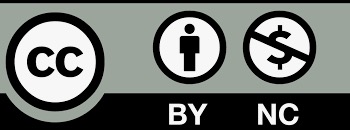Published
2023-06-09
Issue
Section
Research Articles
License
The journal adopts the Attribution-NonCommercial 4.0 International (CC BY-NC 4.0), which means that anyone can reuse and redistribute the materials for non-commercial purposes as long as you follow the license terms and the original source is properly cited.
Author(s) shall retain the copyright of their work and grant the Journal/Publisher rights for the first publication with the work concurrently licensed since 2023 Vol.8 No.2.
Under this license, author(s) will allow third parties to download, reuse, reprint, modify, distribute and/or copy the content under the condition that the authors are given credit. No permission is required from the authors or the publisher.
This broad license intends to facilitate free access, as well as the unrestricted use of original works of all types. This ensures that the published work is freely and openly available in perpetuity.
By providing open access, the following benefits are brought about:
- Higher Visibility, Availability and Citations-free and unlimited accessibility of the publication over the internet without any restrictions increases citation of the article.
- Ease of search-publications are easily searchable in search engines and indexing databases.
- Rapid Publication – accepted papers are immediately published online.
- Available for free download immediately after publication at https://esp.as-pub.com/index.php/ESP

Copyright Statement
1.The authors certify that the submitted manuscripts are original works, do not infringe the rights of others, are free from academic misconduct and confidentiality issues, and that there are no disputes over the authorship scheme of the collaborative articles. In case of infringement, academic misconduct and confidentiality issues, as well as disputes over the authorship scheme, all responsibilities will be borne by the authors.
2. The author agrees to grant the Editorial Office of Environment and Social Psychology a licence to use the reproduction right, distribution right, information network dissemination right, performance right, translation right, and compilation right of the submitted manuscript, including the work as a whole, as well as the diagrams, tables, abstracts, and any other parts that can be extracted from the work and used in accordance with the characteristics of the journal. The Editorial Board of Environment and Social Psychology has the right to use and sub-licence the above mentioned works for wide dissemination in print, electronic and online versions, and, in accordance with the characteristics of the periodical, for the period of legal protection of the property right of the copyright in the work, and for the territorial scope of the work throughout the world.
3. The authors are entitled to the copyright of their works under the relevant laws of Singapore, provided that they do not exercise their rights in a manner prejudicial to the interests of the Journal.
About Licence
Environment and Social Psychology is an open access journal and all published work is available under the Creative Commons Licence, Authors shall retain copyright of their work and grant the journal/publisher the right of first publication, and their work shall be licensed under the Attribution-NonCommercial 4.0 International (CC BY-NC 4.0).
Under this licence, the author grants permission to third parties to download, reuse, reprint, modify, distribute and/or copy the content with attribution to the author. No permission from the author or publisher is required.
This broad licence is intended to facilitate free access to and unrestricted use of original works of all kinds. This ensures that published works remain free and accessible in perpetuity. Submitted manuscripts, once accepted, are immediately available to the public and permanently accessible free of charge on the journal’s official website (https://esp.as-pub.com/index.php/ESP). Allowing users to read, download, copy, print, search for or link to the full text of the article, or use it for other legal purposes. However, the use of the work must retain the author's signature, be limited to non-commercial purposes, and not be interpretative.
Click to download <Agreement on the Licence for the Use of Copyright on Environmental and Social Psychology>.
How to Cite
The Oedipus complex in fiction
Mohammed Ahmed Abou Adel
Al Yamamah University
DOI: https://doi.org/10.18063/esp.v8.i1.1601
Keywords: comparative narrative criticism, heritage employment, Freud’s psychoanalysis, Oedipus complex, world literature
Abstract
This study aims to know The Bookseller’s Notebooks intersects with The Hunchback of Notre Dame and Oedipus Rex. We analyze the novelist’s proficiency at expressing contemporary human issues innovatively and artistically, focusing on the emotional struggle between parents and children. In particular, the study sheds light on the emotional and social struggles suffered by a marginalized, despised, and rejected societal group, namely illegitimate children (foundlings). The study’s findings suggest that more comparative studies of intertextuality between non-local works of literature should be attempted. This way, literature and literary criticism may enhance our understanding of other’s cultures to facilitate acceptance and peaceful coexistence.References
[1]. Kristeva J. Desire in language: A semiotic approach to literature and art. Roudiez LS (editor). Gora T, Jardine A (translators). New York: Columbia University Press; 1980.
[2]. Akdal D, Şahin A. The effects of intertextual reading approach on the development of creative writing skills. Eurasian Journal of Educational Research 2014; 54: 171–186. doi: 10.14689/ejer.2014.54.10.
[3]. Saddar N. Intertextuality in Arabic literary heritage: A reading in the light of the theory transtextuality. Journal of Humanity Sciences 2016; 27(1): 191–222. doi: 10.12785/JHS/20160207.
[4]. Al-Dali S. Shakhsiat Alf Leila Wa Leila—Minn al-banna elly al-tawzif fe al-rawayeh al-arabia (Arabic) [The characters of One Thousand and One Nights—From construction to employment in the Arabic novel]. Oman: Gulf House for Press and Publishing; 2018.
[5]. Yazdani H, Ahmadian M. A study of the effects of intertextuality awareness on reading literary texts: The case of short stories. Journal of Educational and Social Research 2013; 3(2): 155–166. doi: 10.5901/jesr.2013.v3n2p155.
[6]. Juvan M. Generic identity and intertextuality. CLCWeb: Comparative Literature and Culture 2005; 7(1): 1–11. doi: 10.7771/1481-4374.1255.
[7]. Pullinen V. Intertextuality as a source of humour in Terry Pratchett’s novels [Unpublished Master’s thesis]. Finland: University of Jyväskylä; 2016.
[8]. Worton M, Still J. Intertextuality: Theories and practices. Manchester: Manchester University Press; 1990.
[9]. Barthes R. Theory of the text. In: Young R (editor). Untying the text: A post-structuralist reader. London: Routledge; 1981. p. 31.
[10]. Coffee N. An agenda for the study of intertextuality. TAPA 2018; 148(1): 205–223. doi: 10.1353/apa.2018.0008.
[11]. Barjas J. Notebooks of the Bookseller. Lebanon: The Arabic Institute for Research and Publishing; 2021.
[12]. Muslim Bin Al-hajjaj AA, Al-qushayri. Kattab Sahih Muslam (Arabic) [The book of Sahih Muslim]. In: Al-Khattab N (translator). Cairo: Isa’ Al-Babi Al-Halabi Publisher; 1374 AH–1955 AD.
[13]. Ahmed S. Sigmund Freud’s psychoanalytic theory Oedipus complex: A critical study with reference to D.H. Lawrence’s “Sons and Lovers”. Internal Journal of English and Literature 2012; 3(3): 2–22. doi: 10.5897/IJEL11.137.
[14]. Sophocles (429–420 BCE). Oedipus the King. Storr F (translator). London: Wiliam Heinemann Ltd.; 2020.
[15]. Hugo V. The Hunchback of Notre-Dame. Shoberl F (translator). London: Spottiswoode; 1833.







